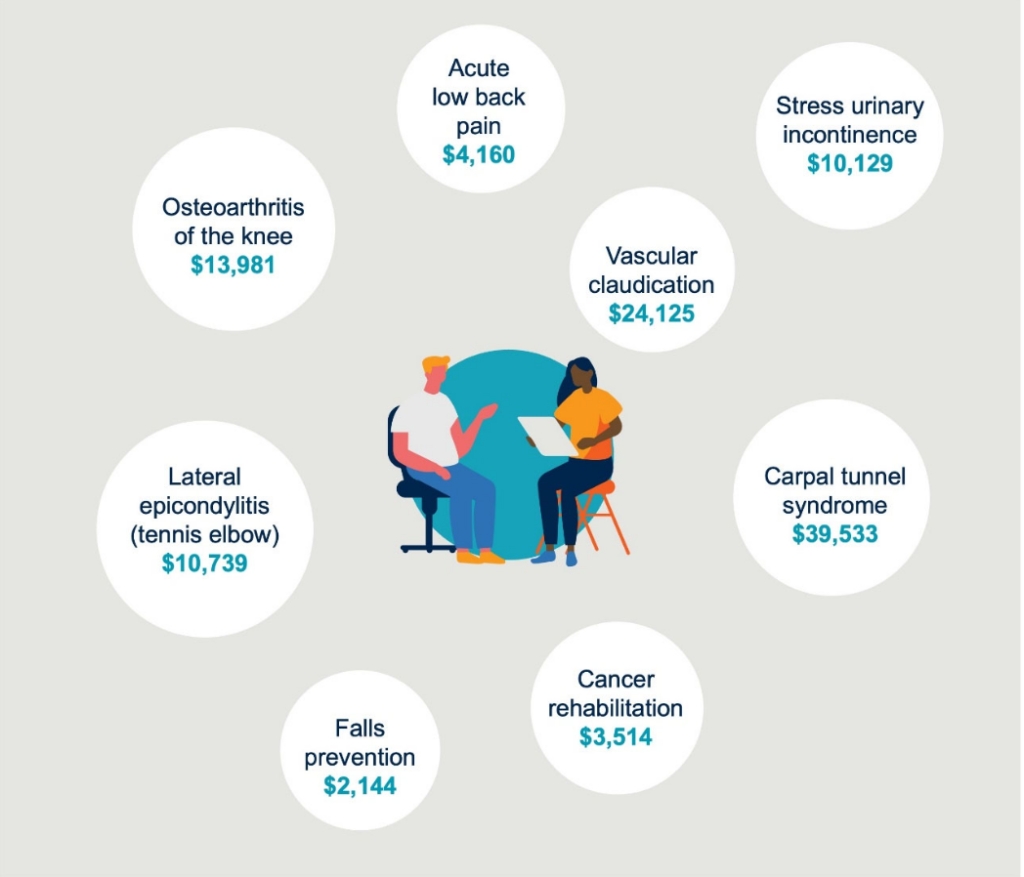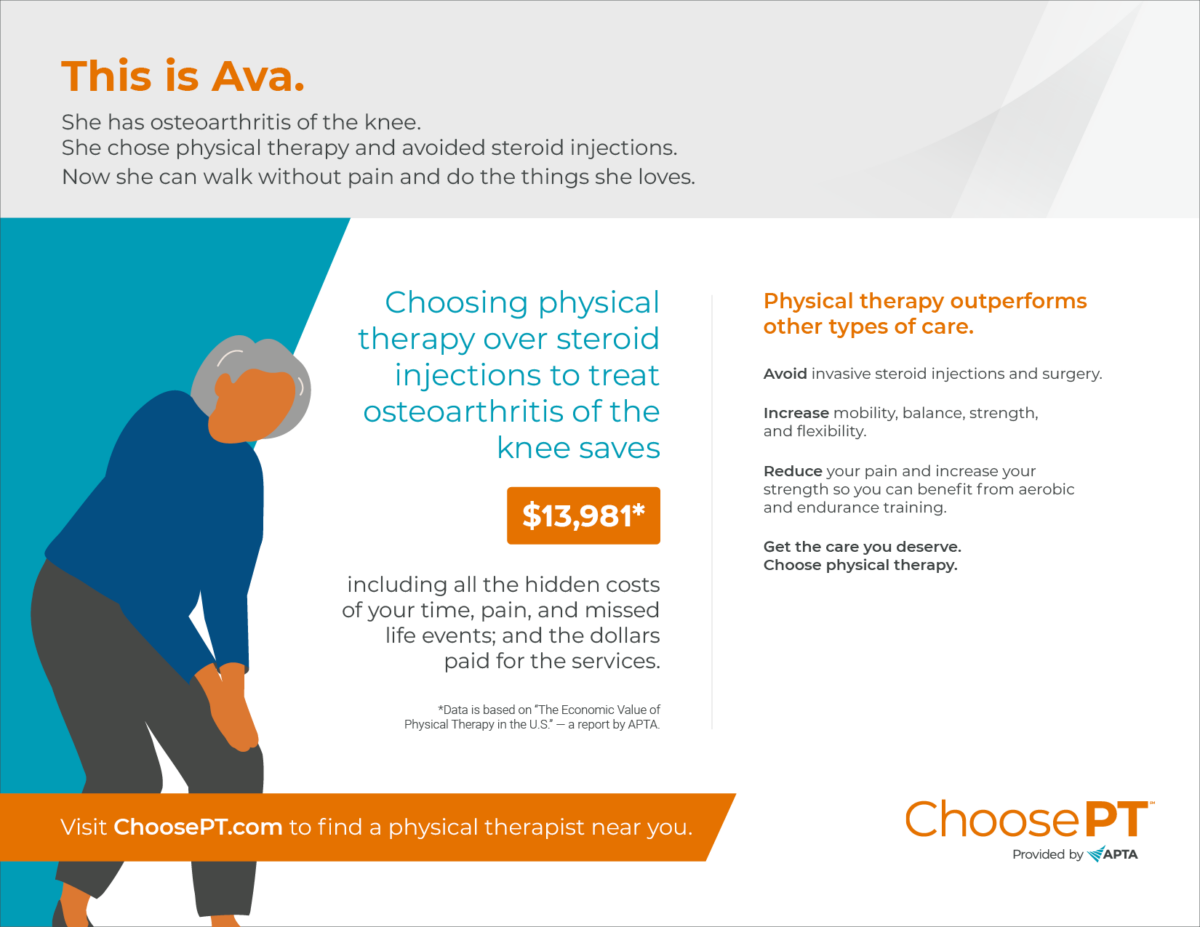Did you know that October is National Physical Therapy Month? Each year, the American Physical Therapy Association uses the month of October to raise awareness about Physical Therapy and the many health benefits that Physical Therapists can provide to the US health care consumer. This year, the focus of the annual PT Month campaign is on increasing public perception about the additional economic benefits that the physical therapy profession provides to the community. In today’s health care system, patients need to be well informed when making health care choices, especially regarding costs and value of health care services. We encourage everyone to read and consider the information associated with the PT Month campaign this year, because the specifics are significant!
A new landmark report was released by the American Physical Therapy Association in conjunction with Physical Therapy Month. “The Economic Value of Physical Therapy in the United States” describes the economic value delivered by physical therapy across a range of common medical conditions. The report makes a compelling case for improved patient access to and improved insurance coverage of physical therapist services. The report summarizes a large-scale research study which calculated the net benefits to patients and to the U.S. health care system of choosing physical therapy over alternative treatments. The findings described in the report underscore the high-value, low-cost interventions that physical therapy offers patients and the health care system.
Physical Therapy Is Vital to the Healthcare System
Physical therapy is vital to the U.S. health care system. Over 300 million physical therapist visits occur every year, and demand for physical therapy is increasing (IBISWorld, 2022). However, Americans face barriers such as low coverage, high copays, and limited access to the physical therapist services they need.
Greater patient access to physical therapists can generate benefits for patients and the health care system alike. For example, physical therapists can alleviate the impact of shortages in primary care physicians, which are expected to reach between 21,000 and 55,000 by 2033 (Clark, 2022). Physical therapy is highly effective, primary-care means of treating musculoskeletal conditions, which account for 8%-18% of physician office caseloads (Clark, 2022), impacting over 127 million Americans and contributing to $213 billion in medical expenditures, lost wages, and decreased productivity annually (Childs, 2022).
Physical therapy treatment is a cost-effective way to manage a wide range of conditions, with proven results that include significant improvements to quality of life through patient education, hands-on care, and prescribed exercise and/or other movement-based activities. Physical therapy provides significant value to the health care system by improving health care outcomes and lowering medical costs.
Physical Therapy Provides Cost Effective Benefits Across a Wide Range of Conditions
The APTA’s report examined the available scientific research on the care delivered across the US medical system for eight common conditions. (Further study is pending for a variety of other conditions for which physical therapy intervention is known to be effective.) An economic analysis was then performed for each condition, comparing physical therapist services to an alternative treatment based on the costs associated with providing care and the benefits produced for the U.S. health care system.
To calculate the benefits of physical therapy for each condition, the estimated improvement to a patient’s quality of life was converted to a dollar figure. To calculate the total cost of the physical therapist services, the following costs were added together: the cost of the services delivered and the estimated cost of the patient’s time spent attending physical therapy appointments (including anticipated travel time to and from appointments). The same process was undertaken for other commonly-utilized medical interventions for each condition.
When the quality-of-life improvement delivered by physical therapist services outweighed the cost of the non-physical therapy-based course of care, physical therapy was found to provide a net economic benefit. The following graphic shows the net benefit demonstrated for choosing physical therapy over alternative means of care for the 8 conditions examined by the study.

The dollar amounts in the figures represent the dollars saved by the patients and the health care system by utilizing physical therapy intervention rather than the various other treatments that are typically recommended for each medical issue. For example – for each patient having a low back pain episode, choosing physical therapy as a first treatment saved approximately $4100, as opposed to treating the issue w/ other common interventions such as opiod pain medications, anti-inflammatory and/or muscle relaxer prescriptions, or steroid injections. Each patient choosing to address their arthritis-related knee pain with physical therapy rather than pain medications, injections of steroids or joint lubricant, or joint replacement surgery can expect a savings in costs of care of almost $14,000! These savings are clearly significant for any one individual person. Then consider that according to health care statistical data, 39% of the US adult population reports suffering a significant low back pain episode at some point during their lives. And 32 million people in the US are affected by osteoarthritis, with the knee joints being very common locations at which to experience arthritic pain. When extrapolating the potential cost savings of physical therapy as opposed to alternative treatments to the entire US population – the cost and value implications are enormous!
#Choose PT to Get the Care That You Deserve
The results in the APTA report demonstrate that, where medically appropriate, more widespread use of the selected physical therapist services would definitively deliver both health and economic benefits to patients and to the U.S. health care system. This information is significant! But in order for this information to matter, systems need to change. Barriers to accessing physical therapists as an entry-point to the health care system – such as prescription and pre-authorization requirements – need to be removed. Insurance payors need to be compelled to provide fair payments to physical therapy providers which are updated on a regular basis and that will cover current market-specific costs of providing service and paying staff. Restrictions to patient use of their physical therapy benefits – such as allowing insurance representatives to arbitrarily determine that payment will not be made for visits that are allowed according a subscriber’s annual plan benefit documents – should be eliminated.
As physical therapists, our next steps are to talk about the findings described in this report with legislators, employers that offer insurance plans to their employees, insurance actuaries and network contract managers, and anyone else that is involved in developing and/or maintaining systems that affect the delivery of health care. Improved awareness of the value of physical therapy is needed in order to improve the function of our current US medical system. Incentivizing the use of physical therapy would save health care consumers and the medical system tons of money, and would also improve the general health and well-being of the entire country’s population.
As health care consumers, you might choose to use this information to prompt you to seek out physical therapy services as a first option whenever you find yourself with a musculoskeletal pain issue or a limitation in your ability to move comfortably during your daily life and/or recreational pursuits. You might also use it to support a request for better insurance coverage through your employer, or to justify a request for authorization for physical therapy care as an alternative to other more expensive and/or invasive medical procedures in circumstances when your insurance plan benefits for physical therapy are limited. Working with a physical therapist is a low-cost, low-risk, high-value way to keep yourself in optimal physical condition. We hope that you will #ChoosePT – during Physical Therapy Month and for future health care needs!

